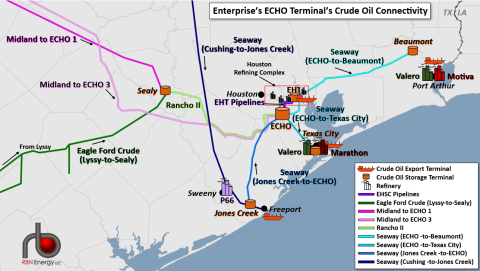A crude oil leak last Tuesday at the Enterprise Crude Houston (ECHO) terminal disrupted regional flows and caused crude differentials to move higher over the course of the week. While the spill was swiftly addressed by terminal owner Enterprise Products Partners, it still affected inbound and outbound operations for a few days. In today’s RBN blog, we discuss the role of the ECHO terminal and show how even an isolated incident can quickly have an impact on the market.
Let’s start with a refresher on the ECHO terminal (large orange tank icon in Figure 1 below) and its surrounding infrastructure. ECHO is one of the largest crude oil terminals along the Gulf Coast and its strategic location in the Houston area, just southeast of Hobby Airport, makes it a prime location for pipelines delivering crude for storage and/or blending, with connections to nearby refineries and export terminals. Designed by Enterprise in 2010, the terminal was originally intended to function as a central storage and distribution hub linking incoming crude from the company’s South Texas and Eagle Ford crude gathering systems and its Seaway Pipeline joint venture (dark-purple line) with Enbridge. It has grown significantly since then thanks to new pipeline connections to the Permian Basin, increased outbound connectivity, and storage capacity that now stands at about 9 MMbbl. In addition, the HOU Intercontinental Exchange (ICE) contract, a physically deliverable futures contract for Midland WTI crude oil, must be delivered into specific terminals, one of which is ECHO (see Let Me Be Myself and Room At The Top.)
Figure 1. Enterprise’s ECHO Terminal’s Crude Oil Connectivity. Source: RBN
Enterprise has two major oil pipelines from the Permian to the Gulf Coast that travel to ECHO. To the Houston area, the long-hauls include the company’s 620-Mb/d Midland to ECHO 1 (M2E-1; dark-pink line) and the 450-Mb/d Midland to ECHO 3 (M2E-3; light-pink line), which represents the company’s 29% undivided interest on the Wink to Webster (W2W) Pipeline. Together, these give Enterprise 1.07 MMb/d of crude takeaway capacity from the Permian to the Gulf Coast. (In addition, Enterprise’s M2E-2 pipeline — currently in NGL service and referred to as Seminole Pipeline — is expected to be converted back to crude service later this year.) M2E-1 flows to Sealy, then uses Enterprise’s Rancho II pipeline (lime-green line), which connects to ECHO. The ExxonMobil-operated 1.5-MMb/d W2W follows the same path for a portion of M2E-1, but flows from Midland directly to ECHO, bypassing Sealy and the Rancho II pipeline.
Join Backstage Pass to Read Full Article









